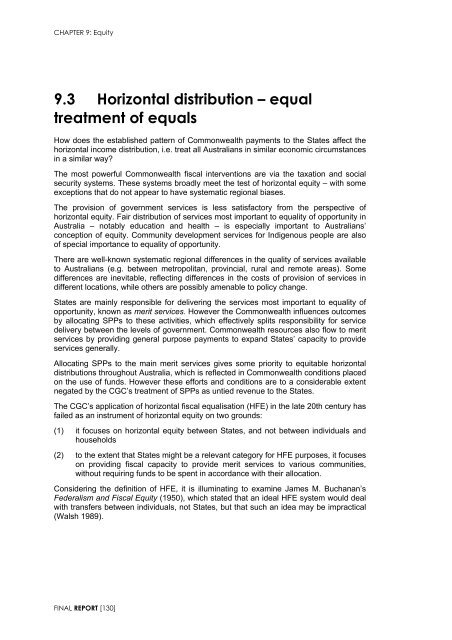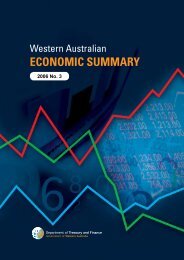Garnaut Fitzgerald Review of Commonwealth-State Funding
Garnaut Fitzgerald Review of Commonwealth-State Funding
Garnaut Fitzgerald Review of Commonwealth-State Funding
Create successful ePaper yourself
Turn your PDF publications into a flip-book with our unique Google optimized e-Paper software.
CHAPTER 9: Equity<br />
9.3 Horizontal distribution – equal<br />
treatment <strong>of</strong> equals<br />
How does the established pattern <strong>of</strong> <strong>Commonwealth</strong> payments to the <strong>State</strong>s affect the<br />
horizontal income distribution, i.e. treat all Australians in similar economic circumstances<br />
in a similar way<br />
The most powerful <strong>Commonwealth</strong> fiscal interventions are via the taxation and social<br />
security systems. These systems broadly meet the test <strong>of</strong> horizontal equity – with some<br />
exceptions that do not appear to have systematic regional biases.<br />
The provision <strong>of</strong> government services is less satisfactory from the perspective <strong>of</strong><br />
horizontal equity. Fair distribution <strong>of</strong> services most important to equality <strong>of</strong> opportunity in<br />
Australia – notably education and health – is especially important to Australians’<br />
conception <strong>of</strong> equity. Community development services for Indigenous people are also<br />
<strong>of</strong> special importance to equality <strong>of</strong> opportunity.<br />
There are well-known systematic regional differences in the quality <strong>of</strong> services available<br />
to Australians (e.g. between metropolitan, provincial, rural and remote areas). Some<br />
differences are inevitable, reflecting differences in the costs <strong>of</strong> provision <strong>of</strong> services in<br />
different locations, while others are possibly amenable to policy change.<br />
<strong>State</strong>s are mainly responsible for delivering the services most important to equality <strong>of</strong><br />
opportunity, known as merit services. However the <strong>Commonwealth</strong> influences outcomes<br />
by allocating SPPs to these activities, which effectively splits responsibility for service<br />
delivery between the levels <strong>of</strong> government. <strong>Commonwealth</strong> resources also flow to merit<br />
services by providing general purpose payments to expand <strong>State</strong>s’ capacity to provide<br />
services generally.<br />
Allocating SPPs to the main merit services gives some priority to equitable horizontal<br />
distributions throughout Australia, which is reflected in <strong>Commonwealth</strong> conditions placed<br />
on the use <strong>of</strong> funds. However these efforts and conditions are to a considerable extent<br />
negated by the CGC’s treatment <strong>of</strong> SPPs as untied revenue to the <strong>State</strong>s.<br />
The CGC’s application <strong>of</strong> horizontal fiscal equalisation (HFE) in the late 20th century has<br />
failed as an instrument <strong>of</strong> horizontal equity on two grounds:<br />
(1) it focuses on horizontal equity between <strong>State</strong>s, and not between individuals and<br />
households<br />
(2) to the extent that <strong>State</strong>s might be a relevant category for HFE purposes, it focuses<br />
on providing fiscal capacity to provide merit services to various communities,<br />
without requiring funds to be spent in accordance with their allocation.<br />
Considering the definition <strong>of</strong> HFE, it is illuminating to examine James M. Buchanan’s<br />
Federalism and Fiscal Equity (1950), which stated that an ideal HFE system would deal<br />
with transfers between individuals, not <strong>State</strong>s, but that such an idea may be impractical<br />
(Walsh 1989).<br />
FINAL REPORT [130]

















